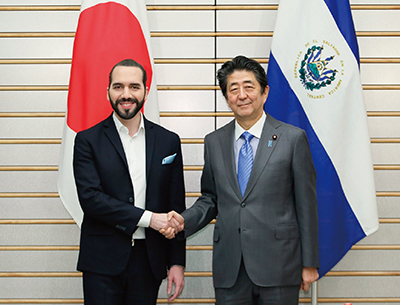Diplomatic Bluebook 2020
Chapter 2
Japan's Foreign Policy that Takes a Panoramic Perspective of the World Map
Section 3 Latin America and the Caribbean
1 Overview
(1) Situations in Latin America and the Caribbean
The Latin American and Caribbean (hereafter referred to as “LAC”) region mostly consists of countries that share universal values with Japan such as democracy, the rule of law, and human rights. It has a population of about 640 million and a GDP of about 5.5 trillion US dollars. It is a major production area for natural resources such as minerals and energy as well as food and has considerable economic potential including its large market. In 2019, the sluggish economic performance in the LAC region was affected by economic stagnation in major countries.
On the political front, in Brazil, a new administration was formed and it promotes liberal economic reform. In Argentina, an administration was inaugurated, and it places importance on equitable development and the protection of the vulnerable population. In addition, in Venezuela, confrontations are continuing between the administration and the opposition parties. Due to the worsening socioeconomic situation in the country, Venezuelan refugees are flowing into neighboring countries, which is greatly affecting the region. Furthermore, destabilizing moves were seen in countries such as Ecuador, Bolivia, and Chile.
In addition, in the LAC region, there are communities of Japanese immigrants and descendants (the Nikkei community) numbering about 2.13 million, or about 60% of the world's Nikkei population. The Nikkei community has fostered a sense of affinity toward Japan in LAC countries through contributions to the local community for more than 100 years. On the other hand, generations have transitioned over 100 years since the Japanese migration began, and the younger generation with relatively little connection to Japan is growing in number.
(2) Japanese Diplomacy towards Latin America and the Caribbean Countries
Japan's diplomacy toward the LAC region has developed under the guiding principle of the three “Juntos” (together) announced by Prime Minister Abe in 2014. In December 2018, Prime Minister Abe summarized the results under this principle for the entire region, and announced the concept of the Initiative to Enhance Connectivity between Japan and Latin America and the Caribbean as the guideline for further cooperation. Japan is aiming to deepen cooperative relations with the LAC countries toward realizing the concept. In 2019, the total number of visits to Japan of the LAC countries' leaders was nine and that of foreign ministers was 13. From Japan, the total number of countries of the LAC region which Ministers, State Ministers and Parliamentary Vice-Ministers visited was 28.
On these occasions, it has been confirmed to strengthen bilateral relations and resolve various issues in the international arena together with LAC countries based on shared fundamental values.
On the economic front, supply chain connections are strengthening, as shown in the doubling of the number of Japanese companies operating in the LAC region since 2011. Japan is working on promoting free trade together with LAC countries including through the Comprehensive and Progressive Agreement for the Trans-Pacific Partnership (TPP11 Agreement), in which Mexico, Peru, and Chile participate.
In the LAC region, countries that have already “graduated” or will “graduate” from the status of recipient countries by achieving economic growth are carrying out South-South cooperation. Japan is promoting triangular cooperation with these countries. On the other hand, Japan is also carrying out cooperation in line with other countries' needs in fields where continuous support is required, including responses to climate change and natural disasters. Japan provided emergency relief goods to the Bahamas following serious damage from Hurricane Dorian in September.
 Japan-El Salvador Summit Meeting (November 29, Tokyo; Photo: Cabinet Public Relations Office)
Japan-El Salvador Summit Meeting (November 29, Tokyo; Photo: Cabinet Public Relations Office)